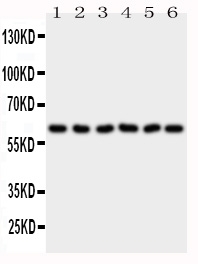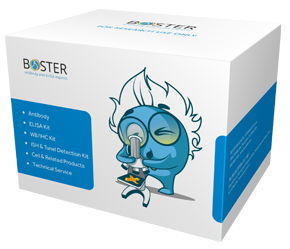Product Info Summary
| SKU: | PA1563 |
|---|---|
| Size: | 100 μg/vial |
| Reactive Species: | Human, Mouse, Rat |
| Host: | Rabbit |
| Application: | WB |
Customers Who Bought This Also Bought
Product info
Product Name
Anti-PAK1 Antibody Picoband®
SKU/Catalog Number
PA1563
Size
100 μg/vial
Form
Lyophilized
Description
Boster Bio Anti-PAK1 Antibody catalog # PA1563. Tested in WB applications. This antibody reacts with Human, Mouse, Rat. The brand Picoband indicates this is a premium antibody that guarantees superior quality, high affinity, and strong signals with minimal background in Western blot applications. Only our best-performing antibodies are designated as Picoband, ensuring unmatched performance.
Storage & Handling
Store at -20˚C for one year from date of receipt. After reconstitution, at 4˚C for one month. It can also be aliquotted and stored frozen at -20˚C for six months. Avoid repeated freeze-thaw cycles.
Cite This Product
Anti-PAK1 Antibody Picoband® (Boster Biological Technology, Pleasanton CA, USA, Catalog # PA1563)
Host
Rabbit
Contents
Each vial contains 5mg BSA, 0.9mg NaCl, 0.2mg Na2HPO4, 0.05mg Thimerosal, 0.05mg NaN3.
Clonality
Polyclonal
Isotype
Rabbit IgG
Immunogen
A synthetic peptide corresponding to a sequence at the N-terminus of human PAK1, different from the related mouse and rat sequences by on amino acid.
*Blocking peptide can be purchased. Costs vary based on immunogen length. Contact us for pricing.
Cross-reactivity
No cross-reactivity with other proteins
Reactive Species
PA1563 is reactive to PAK1 in Human, Mouse, Rat
Reconstitution
Add 0.2ml of distilled water will yield a concentration of 500ug/ml.
Observed Molecular Weight
40 kDa
Calculated molecular weight
60647 MW
Background of Pak1
Serine/threonine-protein kinase PAK 1 is an enzyme that in humans is encoded by the PAK1 gene. PAK proteins are critical effectors that link RhoGTPases to cytoskeleton reorganization and nuclear signaling. PAK proteins, a family of serine/threonine p21-activated kinases, include PAK1, PAK2, PAK3 and PAK4. These proteins serve as targets for the small GTP binding proteins Cdc42 and Rac and have been implicated in a wide range of biological activities. PAK1 regulates cell motility and morphology. Alternative transcripts of this gene have been found, but their full-length natures have not yet been determined. The PAK1 gene is mapped to 11q13-q14 by inclusion within a mapped clone.
Antibody Validation
Boster validates all antibodies on WB, IHC, ICC, Immunofluorescence, and ELISA with known positive control and negative samples to ensure specificity and high affinity, including thorough antibody incubations.
Application & Images
Applications
PA1563 is guaranteed for WB Boster Guarantee
Assay Dilutions Recommendation
The recommendations below provide a starting point for assay optimization. The actual working concentration varies and should be decided by the user.
Western blot, 0.1-0.5μg/ml, Human, Rat, Mouse
Positive Control
WB: Rat Testis Tissue, Rat Spleen Tissue, SW620 Cell, MCF-7 Cell, CEM Cell, HT1080 Cell
Validation Images & Assay Conditions

Click image to see more details
Anti-PAK1 antibody, PA1563, Western blotting
Lane 1: Rat Testis Tissue Lysate
Lane 2: Rat Spleen Tissue Lysate
Lane 3: SW620 Cell Lysate
Lane 4: MCF-7 Cell Lysate
Lane 5: CEM Cell Lysate
Lane 6: HT1080 Cell Lysate
Protein Target Info & Infographic
Gene/Protein Information For PAK1 (Source: Uniprot.org, NCBI)
Gene Name
PAK1
Full Name
Serine/threonine-protein kinase PAK 1
Weight
60647 MW
Superfamily
protein kinase superfamily
Alternative Names
Serine/threonine-protein kinase PAK 1;2.7.11.1;Alpha-PAK;p21-activated kinase 1;PAK-1;p65-PAK;PAK1; PAK1 IDDMSSD, PAKalpha, alpha-PAK, p65-PAK p21 (RAC1) activated kinase 1 serine/threonine-protein kinase PAK 1|STE20 homolog, yeast|p21 protein (Cdc42/Rac)-activated kinase 1|p21/Cdc42/Rac1-activated kinase 1 (STE20 homolog, yeast)|p21/Cdc42/Rac1-activated kinase 1 (yeast Ste20-related)
*If product is indicated to react with multiple species, protein info is based on the gene entry specified above in "Species".For more info on PAK1, check out the PAK1 Infographic

We have 30,000+ of these available, one for each gene! Check them out.
In this infographic, you will see the following information for PAK1: database IDs, superfamily, protein function, synonyms, molecular weight, chromosomal locations, tissues of expression, subcellular locations, post-translational modifications, and related diseases, research areas & pathways. If you want to see more information included, or would like to contribute to it and be acknowledged, please contact [email protected].
Specific Publications For Anti-PAK1 Antibody Picoband® (PA1563)
Hello CJ!
No publications found for PA1563
*Do you have publications using this product? Share with us and receive a reward. Ask us for more details.
Recommended Resources
Here are featured tools and databases that you might find useful.
- Boster's Pathways Library
- Protein Databases
- Bioscience Research Protocol Resources
- Data Processing & Analysis Software
- Photo Editing Software
- Scientific Literature Resources
- Research Paper Management Tools
- Molecular Biology Software
- Primer Design Tools
- Bioinformatics Tools
- Phylogenetic Tree Analysis
Customer Reviews
Have you used Anti-PAK1 Antibody Picoband®?
Submit a review and receive an Amazon gift card.
- $30 for a review with an image
0 Reviews For Anti-PAK1 Antibody Picoband®
Customer Q&As
Have a question?
Find answers in Q&As, reviews.
Can't find your answer?
Submit your question
4 Customer Q&As for Anti-PAK1 Antibody Picoband®
Question
We have seen staining in human cervix carcinoma. Any tips? Is anti-PAK1 antibody supposed to stain cervix carcinoma positively?
Verified Customer
Verified customer
Asked: 2020-04-27
Answer
According to literature cervix carcinoma does express PAK1. According to Uniprot.org, PAK1 is expressed in middle temporal gyrus, placenta, cervix carcinoma, leukemic t-cell, cervix carcinoma erythroleukemia, liver, brain, among other tissues. Regarding which tissues have PAK1 expression, here are a few articles citing expression in various tissues:
Brain, Pubmed ID: 23503467
Cervix carcinoma, Pubmed ID: 16964243, 18669648
Cervix carcinoma, and Erythroleukemia, Pubmed ID: 23186163
Leukemic T-cell, Pubmed ID: 19690332
Liver, Pubmed ID: 24275569
Placenta, Pubmed ID: 8805275
Boster Scientific Support
Answered: 2020-04-27
Question
We are currently using anti-PAK1 antibody PA1563 for mouse tissue, and we are content with the WB results. The species of reactivity given in the datasheet says human, mouse, rat. Is it possible that the antibody can work on dog tissues as well?
Verified Customer
Verified customer
Asked: 2019-08-15
Answer
The anti-PAK1 antibody (PA1563) has not been tested for cross reactivity specifically with dog tissues, though there is a good chance of cross reactivity. We have an innovator award program that if you test this antibody and show it works in dog you can get your next antibody for free. Please contact me if I can help you with anything.
Boster Scientific Support
Answered: 2019-08-15
Question
I would like using your anti-PAK1 antibody for positive regulation of vascular smooth muscle cell proliferation studies. Has this antibody been tested with western blotting on tissue lysate? We would like to see some validation images before ordering.
Verified Customer
Verified customer
Asked: 2019-07-24
Answer
Thanks for your inquiry. This PA1563 anti-PAK1 antibody is tested on rat spleen tissue, testis tissue, tissue lysate, sw620 cell lysate, cem cell lysate, ht1080 cell lysate. It is guaranteed to work for WB in human, mouse, rat. Our Boster guarantee will cover your intended experiment even if the sample type has not been be directly tested.
Boster Scientific Support
Answered: 2019-07-24
Question
My boss were well pleased with the WB result of your anti-PAK1 antibody. However we have seen positive staining in placenta cytoplasm using this antibody. Is that expected? Could you tell me where is PAK1 supposed to be expressed?
Verified Customer
Verified customer
Asked: 2019-02-28
Answer
According to literature, placenta does express PAK1. Generally PAK1 expresses in cytoplasm. Regarding which tissues have PAK1 expression, here are a few articles citing expression in various tissues:
Brain, Pubmed ID: 23503467
Cervix carcinoma, Pubmed ID: 16964243, 18669648
Cervix carcinoma, and Erythroleukemia, Pubmed ID: 23186163
Leukemic T-cell, Pubmed ID: 19690332
Liver, Pubmed ID: 24275569
Placenta, Pubmed ID: 8805275
Boster Scientific Support
Answered: 2019-02-28





